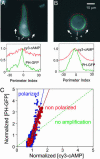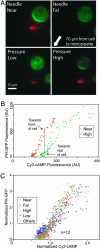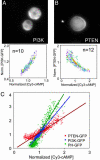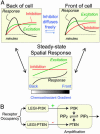Chemoattractant-induced phosphatidylinositol 3,4,5-trisphosphate accumulation is spatially amplified and adapts, independent of the actin cytoskeleton
- PMID: 15184679
- PMCID: PMC428453
- DOI: 10.1073/pnas.0402152101
Chemoattractant-induced phosphatidylinositol 3,4,5-trisphosphate accumulation is spatially amplified and adapts, independent of the actin cytoskeleton
Abstract
Experiments in amoebae and neutrophils have shown that local accumulations of phosphatidylinositol 3,4,5-trisphosphate [PI(3,4,5)P(3)] mediate the ability of cells to migrate during gradient sensing. To define the nature of this response, we subjected Dictyostelium discoideum cells to measurable temporal and spatial chemotactic inputs and analyzed the accumulation of PI(3,4,5)P(3) on the membrane, as well as the recruitment of the enzymes phosphoinositide 3-kinase and PTEN. In latrunculin-treated cells, spatial gradients elicited a PI(3,4,5)P(3) response only on the front portion of the cell where the response increased more steeply than the gradient and did not depend on its absolute concentration. Phosphoinositide 3-kinase bound to the membrane only at the front, although it was less sharply localized than PI(3,4,5)P(3). Membrane-bound PTEN was highest at the rear and varied inversely with receptor occupancy. The localization of PI(3,4,5)P(3) was enhanced further in untreated polarized cells containing an intact cytoskeleton. Interestingly, the treated cells could respond to two independent gradients simultaneously, demonstrating that a response at the front does not necessarily inhibit the back. Combinations of temporal and spatial stimuli provided evidence of an inhibitory process and showed that a gradient generates a persistent steady-state response independent of a previous history of exposure to chemoattractant. These results support a local excitation/global inhibition model and argue against other schemes proposed to explain directional sensing.
Figures






References
Publication types
MeSH terms
Substances
Grants and funding
LinkOut - more resources
Full Text Sources
Other Literature Sources
Research Materials
Miscellaneous

